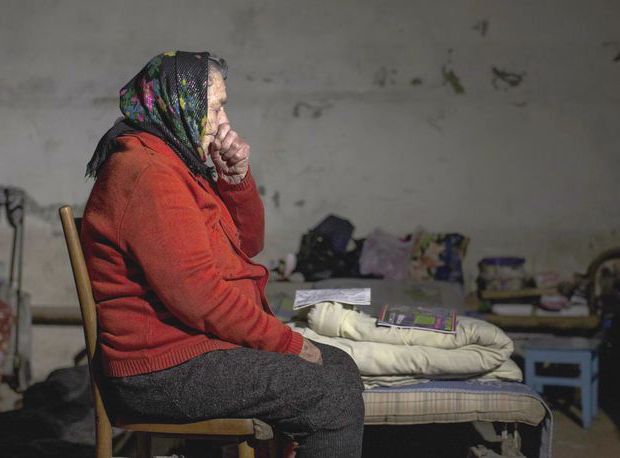Life in an industrial area
Immigrants from the east, who are currently forced to live in... industrial hangars of Kyiv, talk about their lives, challenges, and plans for the future
This industrial site in Kyiv’s Vydubychi neighborhood is reminiscent of landscapes shown in Andrei Tarkovsky’s Stalker. The hum of machines, factories, vacant lots, landfills of junk, very high fences and barbed wire make it hard to believe that people can live here. After two hours of wandering this bizarre across-the-mirror land, I finally found the gate I was looking for.
Part of the site is owned by the Emmanuel Protestant Church. They were the ones to provide shelter to refugees from Donetsk and Luhansk. The concept of “Donbas refugees” is associated by some people with something negative, and legends (sometimes, to be honest, having some truth to them) about the outrages committed by refugees are spreading over social networks and are embellished with fictional details. The positive cases are discussed less frequently and with less enthusiasm, as they enjoy less demand from readers and viewers of the Ukrainian media.
The area’s residents are afraid of the press and do not want to see journalists here, saying that they just malign the refugees. Therefore, I came here with a bag of food and promise to not use my camera. A motley camp is spread out over the slums of this industrial area in the capital. Its residents are mostly women, children, and elderly people. Some move in wheelchairs.
Volodymyr (name changed), who is a coordinator of the camp, met me and invited to share his dinner. He begged my pardon for going to eat in his dirty work clothes. The dining hall has been made out of huge hangars, where these friends in misfortune dine, numbering over 200 people, including 60 children and a couple of disabled. They said that no family with children or disabled had managed to rent a home, these are “the most hopeless categories.”
Other hangars serve as a sleeping area. There are no windows, and the space in the center is partitioned by beams, plywood and rags, with every subdivision furnished with two bunk beds and a cabinet table. It resembles a train compartment in its size and shape. The “entrance” to each of the tiny rooms has a scrap of paper pasted, bearing the room’s number and names and hometowns of its inhabitants. The walls of the hangar serve as a newsfeed, inscribed with telephone hotline numbers of various volunteer groups and news of accommodation and employment offers. The improvised common kitchen is located outside the hangar in the open air. The grim factory yard is “decorated” with scattered children’s toys.
“Everything we have is here thanks to the people of Kyiv!” Volodymyr said. People bring food, clothing, organize cultural programs for children and adults, offer medical and psychological care. The inhabitants of the camp condemn the government and thank volunteers. They say they have left their homes when Petro Poroshenko officially appealed to the civilian population of the Donbas, requesting them to leave the cities for three weeks to allow the anti-terrorist operation to unfold. “We have been sitting here for three months already instead!” Volodymyr told us. The refugees have not seen the social benefits promised by the government either.
The question about how to survive the coming winter hangs in the air. One thing is clear: the iron hangars will not protect from the cold in any way. “We all need to go home!” a gray-haired man says in a barely audible voice, clearly lacking confidence of a quick return. Settling in villages near Kyiv or in the western regions is rejected by the camp’s inhabitants outright – they are afraid of unemployment, which they will supposedly be doomed to there. Here, almost all men have already found a job, “but it is one involving a lot of physical work and low pay for most of us!” our interlocutor said. Interestingly, the “low pay” for some refugees means 3,000 to 4,000 hryvnias per month.
There are difficulties with school places for children as well. After all, the law requires one to be registered at some address to get a school place in this locality. However, it is said that director of the local school, located in Holosiiv district, willingly accommodates refugees and takes all comers.
Another problem for refugee schoolchildren is a psychological one. Although children have generally well adjusted to their changed situation, Volodymyr said that their Kyivan schoolmates were not always welcoming the newcomers, sometimes bullying them and harming their emotional state, while repeated change of school was traumatic for the child.
In parting, I asked how I could help them, what they lacked most. “You better help the army, it is now the top priority! We can survive in the meantime!” Volodymyr responded fervently, making me feel sorry for those Kyivites who believe horror stories about “Easterner outcasts” or call for the Donbas to be blocked off by a concrete wall. Despite all the specifics and unusual features of their mentality, Donetsk and Luhansk send to the rest of Ukraine people who are friendly, fervently patriotic, and decent to a large extent. Too many of them are like that for us to ignore them.
Newspaper output №:
№57, (2014)Section
Day After Day





